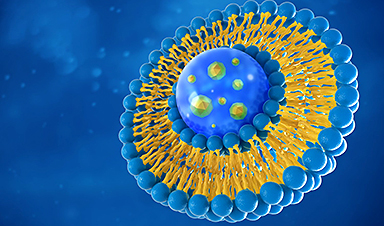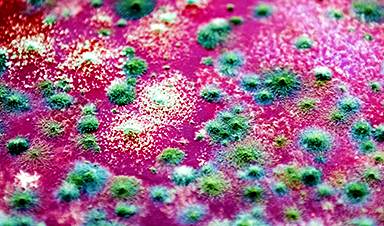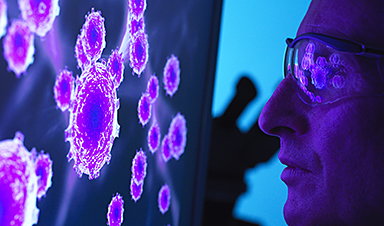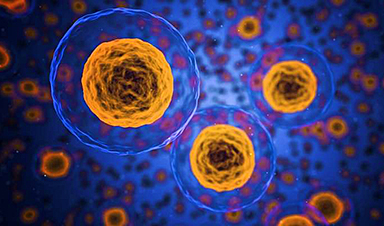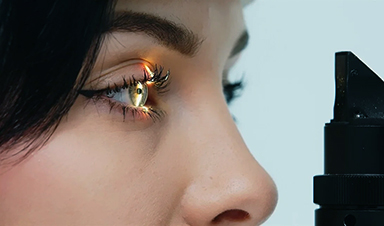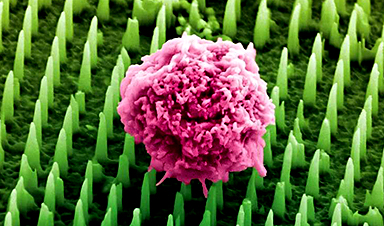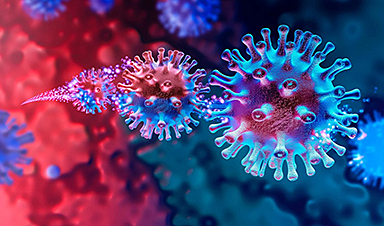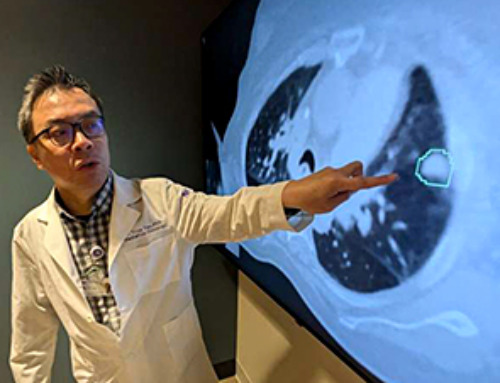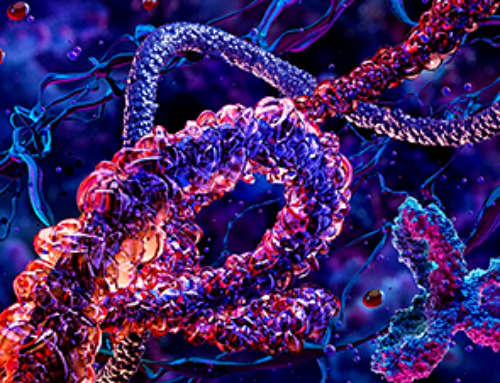Breakthrough medical technology like mRNA vaccines rely on tiny nanoparticles to deliver medicine to cells. A new device will help drug manufacturers and evaluators like the FDA more precisely measure genetic payloads to evaluate drug effectiveness.
An important component of the vaccines protecting people against SARS-CoV-2 virus and its variants are lipid nanoparticles, or LNPs. These circular particles carry therapeutic mRNA payloads, the snippets of genetic material that trigger our immune systems to defend against COVID-19. Even with their success, certain characteristics about the particles, such as payload distribution, are unknown. Researchers and the Food and Drug Administration want more insights about these characteristics to improve metrics reporting in pharmaceutical manufacturing.
A new molecular detection platform developed by two Whiting School of Engineering professors is answering the FDA’s call. Hai-Quan Mao and Tza-Huei (Jeff) Wang want to address how many mRNA molecules an LNP can carry and whether the mRNA is uniformly packed inside the particle to help researchers design more efficient and effective treatments and vaccines.
“Our platform processes molecules at the single nanoparticle level, but unlike the current imaging methods for mRNA LNPs, our approach is based on fluorescent spectroscopy and gives us the ability to see through the particles,” said Wang, a professor in the departments of Mechanical Engineering and Biomedical Engineering at the Whiting School, and a core researcher at the Institute for NanoBioTechnology.
The ability to peer inside the nanoparticles allows the researchers to differentiate between and measure empty LNPs that do not contain mRNA, LNPs with mRNA, and free-floating mRNA in a sample.
Their platform, called cylindrical illumination confocal spectroscopy, or CICS, works by tagging mRNA and LNP components with fluorescent signals of up to three colors and passing the sample through a detection plane. The detection plane reads the fluorescent signals and measures their intensity before comparing the strength of the intensities with that of a single mRNA molecule. The data analysis with an algorithm called deconvolution tells the team both how many mRNA copies are inside the LNP—if any—and their distribution in the sample. The team’s platform overcomes contrast limitations and increases the sample analysis throughput, that are seen in cryo-transmission electron microscopy, the current gold standard for imaging mRNA LNPs.
Tests conducted using this sensing platform revealed that from a benchmark solution of mRNA LNP used in academic research studies, over 50% of the LNPs are not loaded with mRNA molecules, and of the mRNA-filled LNPs, most of them contained two to three mRNA molecules per particle.
“Being able to quantitatively resolve payload characteristics of mRNA LNPs at the single particle level has never been done before. We are intrigued by the substantial presence of empty LNPs, and by altering formulation conditions, a single nanoparticle can load as few as one to as many as ten mRNA molecules.” said Mao, professor in the departments of Materials Science and Engineering and Biomedical Engineering at the Whiting School and director of the Institute for NanoBioTechnology.
The team’s results are published in Nature Communications.
“There are a lot of groups doing LNP research,” Wang said. “However, when they discover a formula that might work well, it has been hard to associate those discoveries back to the composition and payload distribution of the nanoparticles. With this platform we can provide a more comprehensive understanding on what is happening at the single particle level.”
More research is needed to learn how many mRNA molecules per LNP capsule is optimal for the most effective treatment. However, the empty LNPs revealed by the new platform show there is a need to improve methods for packaging the mRNA inside the LNPs.
Mao and Wang say that their platform shows that it has the potential to not only be used at all stages of LNP-related research and development, but also in the development of other drug delivery systems and quality control measures at the manufacturing stage. The team has filed a patent application covering the technique and is working with collaborators to use the platform to analyze other types of therapeutic cargos in diverse nanoparticle systems for treating different diseases.
“The FDA has recently addressed the need for better quality metrics in nanoparticle design in the pharmaceutical industry,” said Michael J. Mitchell, a leading scientist in the field of LNP research and Skirkanich Assistant Professor of Innovation in the Department of Bioengineering at the University of Pennsylvania. “This will become increasingly more important as mRNA LNP technology expands beyond vaccines into new therapeutics that are administered into the bloodstream, which have very stringent requirements. The new detection platform developed by Drs. Mao and Wang’s team is a potentially important step forward in addressing needs at the research and regulatory phase, and can potentially aid in the development of mRNA LNP technology beyond vaccines.”
News
Scientists discover cancer-fighting bacteria that ‘soak up’ forever chemicals in the body
A family of healthy bacteria may help 'soak up' toxic forever chemicals in the body, warding off their cancerous effects. Forever chemicals, also known as PFAS (per- and polyfluoroalkyl substances), are toxic chemicals that [...]
Johns Hopkins Researchers Uncover a New Way To Kill Cancer Cells
A new study reveals that blocking ribosomal RNA production rewires cancer cell behavior and could help treat genetically unstable tumors. Researchers at the Johns Hopkins Kimmel Cancer Center and the Department of Radiation Oncology and Molecular [...]
AI matches doctors in mapping lung tumors for radiation therapy
In radiation therapy, precision can save lives. Oncologists must carefully map the size and location of a tumor before delivering high-dose radiation to destroy cancer cells while sparing healthy tissue. But this process, called [...]
Scientists Finally “See” Key Protein That Controls Inflammation
Researchers used advanced microscopy to uncover important protein structures. For the first time, two important protein structures in the human body are being visualized, thanks in part to cutting-edge technology at the University of [...]
AI tool detects 9 types of dementia from a single brain scan
Mayo Clinic researchers have developed a new artificial intelligence (AI) tool that helps clinicians identify brain activity patterns linked to nine types of dementia, including Alzheimer's disease, using a single, widely available scan—a transformative [...]
Is plastic packaging putting more than just food on your plate?
New research reveals that common food packaging and utensils can shed microscopic plastics into our food, prompting urgent calls for stricter testing and updated regulations to protect public health. Beyond microplastics: The analysis intentionally [...]
Aging Spreads Through the Bloodstream
Summary: New research reveals that aging isn’t just a local cellular process—it can spread throughout the body via the bloodstream. A redox-sensitive protein called ReHMGB1, secreted by senescent cells, was found to trigger aging features [...]
AI and nanomedicine find rare biomarkers for prostrate cancer and atherosclerosis
Imagine a stadium packed with 75,000 fans, all wearing green and white jerseys—except one person in a solid green shirt. Finding that person would be tough. That's how hard it is for scientists to [...]
Are Pesticides Breeding the Next Pandemic? Experts Warn of Fungal Superbugs
Fungicides used in agriculture have been linked to an increase in resistance to antifungal drugs in both humans and animals. Fungal infections are on the rise, and two UC Davis infectious disease experts, Dr. George Thompson [...]
Scientists Crack the 500-Million-Year-Old Code That Controls Your Immune System
A collaborative team from Penn Medicine and Penn Engineering has uncovered the mathematical principles behind a 500-million-year-old protein network that determines whether foreign materials are recognized as friend or foe. How does your body [...]
Team discovers how tiny parts of cells stay organized, new insights for blocking cancer growth
A team of international researchers led by scientists at City of Hope provides the most thorough account yet of an elusive target for cancer treatment. Published in Science Advances, the study suggests a complex signaling [...]
Nanomaterials in Ophthalmology: A Review
Eye diseases are becoming more common. In 2020, over 250 million people had mild vision problems, and 295 million experienced moderate to severe ocular conditions. In response, researchers are turning to nanotechnology and nanomaterials—tools that are transforming [...]
Natural Plant Extract Removes up to 90% of Microplastics From Water
Researchers found that natural polymers derived from okra and fenugreek are highly effective at removing microplastics from water. The same sticky substances that make okra slimy and give fenugreek its gel-like texture could help [...]
Instant coffee may damage your eyes, genetic study finds
A new genetic study shows that just one extra cup of instant coffee a day could significantly increase your risk of developing dry AMD, shedding fresh light on how our daily beverage choices may [...]
Nanoneedle patch offers painless alternative to traditional cancer biopsies
A patch containing tens of millions of microscopic nanoneedles could soon replace traditional biopsies, scientists have found. The patch offers a painless and less invasive alternative for millions of patients worldwide who undergo biopsies [...]
Small antibodies provide broad protection against SARS coronaviruses
Scientists have discovered a unique class of small antibodies that are strongly protective against a wide range of SARS coronaviruses, including SARS-CoV-1 and numerous early and recent SARS-CoV-2 variants. The unique antibodies target an [...]
